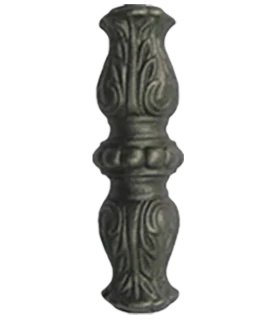interior sliding door rollers
Understanding Interior Sliding Door Rollers A Comprehensive Guide
Sliding doors have become a popular choice in modern interior design, offering a sleek and space-saving alternative to traditional hinged doors. Whether you're looking to install a new sliding door or troubleshoot an existing one, understanding the components involved, particularly the rollers, is essential for smooth operation and longevity. This article offers insights into what sliding door rollers are, their significance, types, and maintenance tips.
What Are Interior Sliding Door Rollers?
Interior sliding door rollers are specialized hardware components that enable the door to glide smoothly along a track. They are typically mounted at the top (and sometimes the bottom) of the door and are crucial for the door's mobility. Rollers can vary in design, size, and material, but their primary purpose remains the same to facilitate effortless sliding movement.
Importance of Sliding Door Rollers
The rollers are vital for several reasons
1. Smooth Operation High-quality rollers ensure that the door opens and closes with minimal effort, enhancing user experience. 2. Stability and Safety Properly functioning rollers help maintain the door's stability while in motion, preventing accidents that could occur if the door were to derail.
3. Longevity of the Door Good rollers can extend the life of the sliding door by reducing wear and tear on both the door and the track.
4. Aesthetic Appeal A smoothly operating door contributes to the overall aesthetic of a room, providing a clean and modern look.
Types of Sliding Door Rollers
When selecting rollers for sliding doors, it's important to consider the various types available
1. Ball Bearing Rollers These are designed with ball bearings that allow for reduced friction, enabling smoother and quieter operation. They are ideal for heavy doors.
interior sliding door rollers

2. Polymer Rollers Made from durable plastic, polymer rollers are lightweight and resist corrosion. They are often used in residential applications due to their aesthetic appeal and reasonable price point.
3. Single Wheel vs. Multi-Wheel Rollers Single wheel rollers are simpler and typically found on lighter doors. In contrast, multi-wheel rollers distribute weight more evenly, making them better suited for heavier doors.
4. Adjustable Rollers These rollers allow for height adjustment, ensuring the door hangs correctly, which is crucial for a seamless fit in the track.
Maintenance Tips for Sliding Door Rollers
To ensure the optimal performance of your sliding door rollers, regular maintenance is essential
1. Clean the Track Dust and debris can accumulate in the track, impeding the rollers. Regularly vacuuming and cleaning the track helps prevent this issue.
2. Lubricate the Rollers Use a silicone-based lubricant to keep the rollers functioning smoothly. Avoid grease-based products, as they can attract dirt and grime.
3. Check for Damage Periodically inspect the rollers for signs of wear or damage. If you notice any issues, consider replacing them to maintain functionality.
4. Align the Door Ensure that the door is properly aligned with the track. Misalignment can cause excessive wear on the rollers and lead to operational issues.
5. Replace Worn Rollers Don’t hesitate to replace rollers that show significant signs of wear and tear. Doing so can greatly improve the door’s functionality.
Conclusion
Understanding the role of interior sliding door rollers is integral to maintaining and enhancing the performance of your sliding doors. By selecting the right type of roller for your specific door and committing to regular maintenance, you can ensure that your sliding doors operate smoothly and efficiently for years to come. Whether you're a homeowner, a DIY enthusiast, or a professional contractor, being knowledgeable about sliding door components will enable you to make informed decisions and create functional yet stylish spaces in your home.
-
Wrought Iron Components: Timeless Elegance and Structural StrengthNewsJul.28,2025
-
Window Hardware Essentials: Rollers, Handles, and Locking SolutionsNewsJul.28,2025
-
Small Agricultural Processing Machines: Corn Threshers, Cassava Chippers, Grain Peelers & Chaff CuttersNewsJul.28,2025
-
Sliding Rollers: Smooth, Silent, and Built to LastNewsJul.28,2025
-
Cast Iron Stoves: Timeless Heating with Modern EfficiencyNewsJul.28,2025
-
Cast Iron Pipe and Fitting: Durable, Fire-Resistant Solutions for Plumbing and DrainageNewsJul.28,2025
-
 Wrought Iron Components: Timeless Elegance and Structural StrengthJul-28-2025Wrought Iron Components: Timeless Elegance and Structural Strength
Wrought Iron Components: Timeless Elegance and Structural StrengthJul-28-2025Wrought Iron Components: Timeless Elegance and Structural Strength -
 Window Hardware Essentials: Rollers, Handles, and Locking SolutionsJul-28-2025Window Hardware Essentials: Rollers, Handles, and Locking Solutions
Window Hardware Essentials: Rollers, Handles, and Locking SolutionsJul-28-2025Window Hardware Essentials: Rollers, Handles, and Locking Solutions -
 Small Agricultural Processing Machines: Corn Threshers, Cassava Chippers, Grain Peelers & Chaff CuttersJul-28-2025Small Agricultural Processing Machines: Corn Threshers, Cassava Chippers, Grain Peelers & Chaff Cutters
Small Agricultural Processing Machines: Corn Threshers, Cassava Chippers, Grain Peelers & Chaff CuttersJul-28-2025Small Agricultural Processing Machines: Corn Threshers, Cassava Chippers, Grain Peelers & Chaff Cutters












